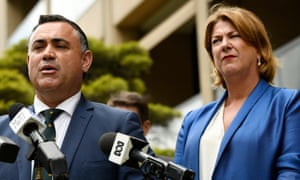There’s no surer sign that a politician is looking towards some kind of advancement than when they jump on to a populist cause – and to hell with the facts.
This week the New South Wales deputy premier and National party leader, John Barilaro, excelled himself when he declared he would be prepared to “rip up” the Murray-Darling basin plan and has asked for legal advice on whether the state government can “walk away” from it.
He said we should be “pausing all water-sharing plans” while the drought continued, and “we need to put people before the environment”.
He has been aided and abetted by the state’s water minister, Melinda Pavey, who criticised the release of water down the Lachlan River by the commonwealth environment water holder as “blind recklessness” while towns along the valley faced the prospect of running dry.
“Farmers have been blamed for a lot while the CEWH continues to pour water down the river without any regard for our communities doing it tough,” Pavey said.
These statements exploit people’s strong sympathy for farmers and their plight, but without the slightest effort to explain the facts or the science behind environmental water.
And they are almost certainly being made for motives that owe more to the Nationals’ existential struggle with the Shooters, Fishers and Farmers party and Barilaro’s own ambition.
Fish kills: just the beginning
But back to the facts.
The Murray-Darling basin plan was agreed to by the states and territories in 2007 because there was general recognition there had been historic over-allocation of the available water in the system, which if unaddressed would lead to environmental catastrophe.

The basin states and territories eventually agreed to an environmentally sustainable level of take by irrigators and an allocation of environmental flows, because otherwise the river system was going to die, with enormous environmental, social and economic consequences.
Major fish kills would be the tip of the iceberg. Mass die-offs of river red gums, loss of breeding grounds for birds and fish, rising salinity and undrinkable water for towns along the river were on the cards.
Even now, scientists worry that the plan didn’t go far enough. The scientific consensus was that the 2750GL target for environmental water was the bare minimum to repair the river.
“The entire point of the basin plan is to share water between people and rivers, particularly during drought,” says Rod Campbell, research director at the Australia Institute. “The current management of the basin was set up by John Howard specifically in response to drought.”
The other critical part of the reforms was to create legally enforceable and tradable water rights. The commonwealth has spent billions of dollars of taxpayers’ money buying water entitlements back from farmers for the environment. Some farmers and agribusinesses have made millions trading water entitlements.
The advantage of the scheme is that farmers who hold high-security water rights know that even in a drought they have a legally enforceable right to water.
Water rights of lesser value – general security and supplementary rights – don’t have the same guarantee of access. Farmers know that in a drought the chances are they won’t get their full entitlement, and may not get any water.
The plan also includes a hierarchy of needs. Water for critical human uses in towns comes first, then water for stock, then high-security water, then general security water.
On 1 July each year, the states declare what the allocation against these entitlements will be. In a drought, the general security and supplementary water users lose out first. Most have zero allocations this year.
Those who hold high-security water might get a cut too, but this year they are still receiving about 97% in most valleys.
In a drought the allocations for environmental water are reduced as well.
Science before politics
What has outraged Pavey and Barilaro was the decision by the commonwealth environmental water holder to let 22GL of its entitlement in the Lachlan river system flow down the river in mid-September to flush the system and water the Cumbung swamp.
David Papps, a former commonwealth environmental water holder, said the decisions on environmental water were based on world-class science and that the priorities were set in consultation with the states.
He said criticising the commonwealth environmental water holder amounted to an explicit criticism of the NSW environment minister, Matt Kean, because his department signed off on the decision.
“Just because there’s a drought doesn’t mean we can abandon environmental watering,” he said. “These are assets that were already under stress because of our mismanagement of the Murray-Darling.”

Papps also warned Barilaro and Pavey that they should be very wary of the precedent that would be set by disregarding or overriding environmental water entitlements.
“The strength of the architecture of the plan is that environmental water rights are the same legal instruments as other water holders,” he said. “If you trash legally enforceable rights to water for one holder, then it will devalue the rights of all.
“If the Nationals override the rights of the environmental water holder, it would mean that a future Labor government could decide to unilaterally repudiate the rights of irrigators.”
Papps also pointed out that state governments already have ample powers to protect water for towns: they can declare an embargo on pumping in any valley to protect the last of the water in dams for use by towns.
But this would mean that irrigators with high security licences would also have to stop pumping. Even in the middle of this drought, there will be cotton grown in parts of NSW – but that’s how the system works. If a farmer has a water allocation, it is up to the farmer to decide what is the highest value crop to grow. And the farmer has certainty that the water will be delivered.
“Barilaro seems not to understand that the plan and the commonwealth environmental water holder were set up, and paid for, in order to use environmental water based on science, not on what might get him in the newspapers,” Campbell said.
“Barilaro’s ideas aren’t just bad for the health of our river system, or for science-based policy, but they’re bad for all owners of water rights.
“While the science behind our water management has been badly compromised, hopefully we don’t yet use water in whatever way a deputy premier feels like on a given day.”
Papps suggested that Barilaro’s posturing owed more to politics, and a long-term goal of trying to get rid of a final stage of the plan which will see a further 450GL of water retrieved for the environment.
There is intense speculation that Barilaro is positioning himself for a run at the federal seat of Eden-Monaro, which would be vulnerable if the sitting member, Labor’s Mike Kelly, called it a day.
In August the NSW premier, Gladys Berejiklian, recommitted to the Murray-Darling basin plan at the Council of Australian Governments meeting.
Papps said: “The basin plan is a truly significant national reform that is fundamental to ensuring the health of the basin’s environment into the future and its unconscionable for it to be under threat from the petty and self-interested politics of the NSW National party.”








